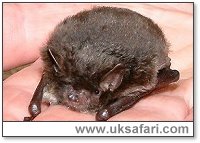
|

|
|
 Sent
to you Sent
to you
by e-mail
|
|
Simply
enter your details and hit the send button
more
info |
|


Click Here

Links
Advertise
Terms of Use
Contributors
About Us
Contact Us
|
 |
Go back
 | Bookmark
| Bookmark
 | Print Page
| Print Page  | E-Mail Us
| E-Mail Us 
 

Photo: G. Bradley |
|
UK
Safari Tip:
You can find bats and listen in on what they're saying with your own bat
detector - click here
|
|
Latin name: Myotis daubentoni
Size: Wingspan up to 25cms.
Distribution: Found throughout most of the UK.
Months seen: April to October.
Food: Flies and midges.
Habitat: Roosts in trees and bridges over water.
Echolocation Frequency: 40 - 45 kHz
Special features: The Daubenton's bat is sometimes called the 'water bat' because it is nearly always seen flying over or near still or slow moving water. Slow moving water makes less noise and so it doesn't interfere with their echo-location.
The fur is quite shaggy, creamy-white on the tummy, and slightly bald around they are nose. They have triangular ears with a small
tragus.
 One of the key distinguishing features of the Daubenton's species are the large feet with hairy toes.
One of the key distinguishing features of the Daubenton's species are the large feet with hairy toes.

Bat Identification
Charts
Bat Calls on CD - Learn to Identify Different
Species
Bat Detectors
UK Safari Bat Section
What is Echolocation?
What does a bat sound like?
What is a tragus?
Links to Bat Groups in Britain
|
 |

|